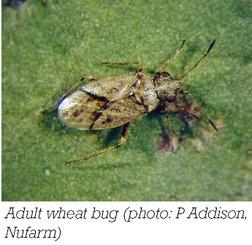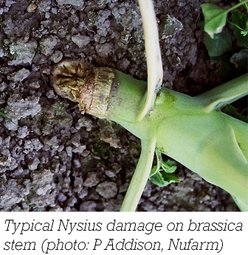Nysius
Wheat bug
Nysius huttoni (also known as wheat bug) is found throughout NZ, particularly in the drier Central and North Otago and East Coast regions. It causes damage to emerging brassica crops by feeding on the young stems.
Identification
Eggs when first laid are creamy white but turn to deep orange by the time of hatching. There are five wingless nymphal stages, with the first being around 0.5 mm long and pale to dark orange in colour, while later stages are up to 2 mm long and grey to brown-grey in colour.

Adults are about 4 mm long and usually a pale green colour initially, but change to a dull brownish grey as time progresses. The adults have a dappled appearance with a conspicuous silvery triangle at the tail end.
There can be up to four generations in a year. During summer months the insects are active fliers. This period also coincides with the major period of damage to brassica crops, as they emerge.
They damage brassica crops by puncturing around the base of seedlings, which causes an open wound to form in the tissues. Young seedlings can die quickly, while the damage has a ring-barking effect on older seedlings. The full extent of damage may only be seen at later stages in growth, where the plant may break off at ground level in strong winds.

Prevention and management
Seed treatment, such as AGRICOTE Brassica, offers the best early protection against this pest. If seed has not been treated, an application of insecticide at the final spray out or at early emergence is recommended to avoid large crop losses at this stage.

